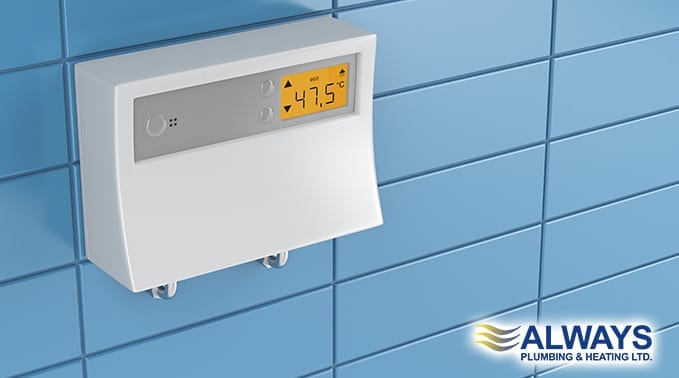The cost to heat your water day after day can be, to put it mildly, costly. Edmonton homeowners shell out money hand over fist each month to pay for the hot water that powers their dishwasher, laundry, sink and shower, and it adds up quickly. A traditional water heater powers it all just fine, but there are drawbacks to having one in your home.
They take up a lot of space. They’re prone to leakage and flooding. You can run out of hot water if the pre-filled tank runs out. To compensate for their shortcomings, you can opt to install a tankless water heater. These smaller, cheaper water heaters have their own pros and cons, and they can end up being better for you depending on your home. Always Plumbing & Heating has provided a list of benefits and drawbacks so that you can make an informed decision about whether a tankless water heater is right for you or not.
First – How Tankless Water Heaters Work
Tankless water heaters are just that – tankless. They eliminate the bulky storage unit a regular water heater has and instead uses a heat exchanger that cold water passes through, warming it to the temperature you’ve set it at. This way, you only get the water you need instead of drawing from a previously filled tank.
Benefits
It’s not hard to see why a tankless water heater is appealing. It saves space, eliminates the money you have to pay to continually heat the water in a larger tank, instead only heating water when you need it. Thus, the energy use gets whittled down.
- The worries about a flooded basement become a thing of the past. Without a tank, there’s nothing to potentially spring a leak.
- Tankless water heaters are less prone to breaking, so you won’t need to shell out the money to have them repaired. And because they have fewer parts that need replacing, tankless water heaters typically last longer than traditional water heaters (about 20 years compared to 15).
Those are nice, but the real selling point is the money you’ll save. A family can save more than $100 a year in energy-bill savings, thanks to the efficiency of a tankless water heater. By only heating water when it’s needed, you’re not paying for unnecessary heat all the time.
Drawbacks
That said, it’s not all sunshine and rainbows: there are drawbacks, and they’re worth considering.
- Since a tankless water heater is smaller than a traditional unit and therefore pumps water through at a slower rate, it might not be able to handle the output you require. A typical unit is able to heat 2-5 gallons of water per minute — a shower pumps out roughly 7 gallons of water a minute; a tankless water heater might not be able to keep up. If your home is bigger and needs more power, you might have to install a few of these water heaters to sufficiently meet the needs of your appliances.
- The up-front cost for a tankless water heater can be a deterrent. The average cost for one – including installation – can climb into the $2,000-$3,000 range depending on the type of water heater you want as well as the size and power it generates.
- If the unit you’re eyeing is electric-powered, you might need more outlets to power them, and gas-powered water heaters expel greenhouse gases into the atmosphere.
So, the decision to splurge and have a tankless water heater isn’t a quick or easy one, but it can pay off in the long run if you can handle the cost up front. If you do decide to take the plunge, installation of one isn’t something that you should attempt on your own. The experts at Always Plumbing & Heating are equipped to fully install a tankless water heater at your home, and we’ll do it right the first time. Give us a call at 780-489-8118 for the most reliable service in Edmonton today!
